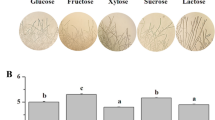Abstract
The optimization of taxol production by Fusarium redolens by one factor at a time (OFAT) approach led to production of 70 μg/L of taxol. With sucrose and NH4NO3 as the carbon and nitrogen sources and medium volume (V m ) to flask volume (V f ) ratio of 0.2, a greater taxol production was attained. NH4NO3, MgSO4↔7H2O and NaOAc at 6.25, 0.63, and 1.25 g/L, were the significant factors for attaining the highest taxol production. The optimization of culture variables led to the production of taxol from 66 to 198 μg/L, which is three fold higher than that in the unoptimized medium. Current study results suggested the success of Response Surface Methodology in enhancing the production of fungal taxol.
Similar content being viewed by others
References
Wani, M. C., H. L. Taylor, M. E. Wall, P. Coggon, and A. T. McPhail (1971) Plant antitumor agents VI: The isolation and structure of taxol, a novel antileukemic and antitumor agent from Taxus brevifolia. J. Am. Chem. Soc. 93: 2325–2327.
Striff, P. B., J. Fant, and S. B. Horwitz (1979) Promotion of microtubule assembly in vitro by taxol. Nature 277: 665–667.
Holmes, F. A., R. S. Walters, R. L. Theriault, A. D. Forman, L. K. Newton, M. N. Raber, A. U. Buzdar, D. K. Frye, and G. N. Hortabagyi (1991) Phase II trial of taxol, an active drug in the treatment of metastatic breast cancer. J. Natl. Cancer Inst. 83: 1797–1805.
McGuire, W. P., E. K. Rowinsky, N. B. Rosenshein, F. C. Grumbine, D. S. Ettinger, D. K. Armstrong, and R. C. Donehower (1989) Taxol: A unique antineoplastic agent with significant activity in advanced ovarian epithelial neoplasms. Ann. Intern. Med. 111: 273–279.
Pulkkinen, J. O., L. Elomaa, H. Joensuu, P. Martikainen, K. Servomaa, and R. Grenman (1996) Paclitaxel-induced apoptotic changes followed by time-lapse video microscopy in cell lines established from head and neck cancer. J. Cancer Res. Clin. Oncol. 122: 214–218.
Rowinsky, E. K., L. A. Cazenave, and R. C. Donehower (1990) Taxol: A novel investigational antimicrotubule agent. J. Natl. Cancer Inst. 17: 283–304.
Yunan, J. H., R. P. Zhang, R. G. Zhang, L. X. Guo, X. W. Wang, D. Luo, Y. Xie, and H. Xie (2000) Growth inhibiting effects of taxol on human liver cancer in vitro and in nude mice. World J. Gastroentrol. 6: 210–215.
Li, J.Y., R. S. Sidhu, E. J. Ford, D. M. Long, W. M. Hess, and G. A. Strobel (1998) The induction of taxol production in the endophytic fungus- Periconia sp. from Torreya grandifolia. J. Ind. Microbiol. 20: 259–264.
Stierle, A., G. Strobel, and D. Stierle (1993) Taxol and taxane production by Taxomyces andreanae, an endophytic fungus of Pacific yew. Science 260: 214–216.
Strobel, G. A., W. M. Hess, E. Ford, R. S. Sidhu, and X. Yang (1996) Taxol from fungal endophytes and the issue of biodiversity. J. Ind. Microbiol. 17: 412–423.
Strobel, G. A., X. Yang, J. Sears, R. Kramer, R. Sidhu, and W. M. Hess (1996) Taxol from Pestalotiopsis microspora, an endophytic fungus of Taxus wallichiana. Microbiol. 142: 435–440.
Wang, J., G. Li, H. Lu, Z. Zheng, Y. Huang, and W. Su (2000) Taxol from Tubercularia sp. strain TF5, an endophytic fungus of Taxus mairei. FEMS Microbiol. Lett. 193: 249–253.
Plackett, R. L. and J. P. Burman (1946) The design of optimum multifactorial experiments. Biometrika. 33: 305–325.
Box, G. E. P. and D. W. Behnken (1960) Some new three level designs for the study of quantitative variables. Technomet. 2: 455–475.
Feng, X., T. Wenyi, C. Long, and G. Lijia (2006) Strain improvement and optimization of the media of taxol-producing fungus Fusarium maire. Biochem. Eng. J. 31: 67–73.
Luo, J. and G. Y. He (2004) Optimization of elicitors and precursors for Paclitaxel production in cell suspension culture of Taxus chinesis in the presence of nutrient feeding. Proc. Biochem. 39: 1073–1079.
Srivastava, S. and A. K. Srivastava (2012) Statistical medium optimization for enhanced azadirachitin production in hairy root culture of Azadirachta indica. In Vitro Cell Dev. Biol. Plant. 48: 73–84.
Wang, J., L. Yao, and Y. Lu (2013) Ceriporia lacerata DMC1106, a New Endophytic Fungus: Isolation, Identification, and Optimal Medium for 2′,4′-dihydroxy-6′-methoxy-3′,5′-dimethylchalcone Production. Biotechnol. Bioproc. Eng. 18: 669–678.
Garyali, S., A. Kumar, and M. S. Reddy (2013) Taxol production by an endophytic fungus, Fusarium redolens, isolated from Himalayan yew. J. Microbiol. Biotechnol. 23: 1372–1380.
Nadeem, M., H. C. Rikhari, A. Kumar, L. M. S. Palni, and S. K. Nandi (2002) Taxol content in the bark of Himalayan Yew in relation to tree age and sex. Phytochem. 60: 627–631.
Huang, Y. J., J. F. Wang, G. L. Li, Z. Zheng, and W. J. Su (2001) Antitumor and antifungal activities in endophytic fungi isolated from pharmaceutical plants Taxus mairei, Cephalataxus fortunei and Torreya grandis. FEMS Immunol. Med. Microbiol. 1: 163–167.
Parra, R., D. Aldred, and N. Magan (2005) Medium optimization for the production of the secondary metabolite squalestatin S1 by a Phoma sp. combining orthogonal design and response surface methodology. Enz. Microb. Technol. 37: 704–711.
Zhao, K., Z. Li, N. Ge, X. Li, X. Wang, and D. Zhou (2011) Investigation of fermentation conditions and optimization of medium for taxol production from taxol-producing fungi. J. Med. Plant. Res. 5: 6528–6535.
Author information
Authors and Affiliations
Corresponding author
Rights and permissions
About this article
Cite this article
Garyali, S., Kumar, A. & Reddy, M.S. Enhancement of taxol production from endophytic fungus Fusarium redolens . Biotechnol Bioproc E 19, 908–915 (2014). https://doi.org/10.1007/s12257-014-0160-z
Received:
Revised:
Accepted:
Published:
Issue Date:
DOI: https://doi.org/10.1007/s12257-014-0160-z




